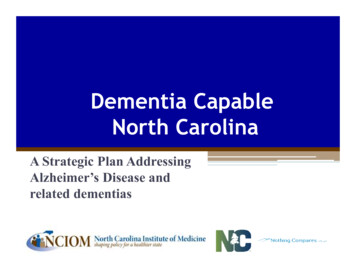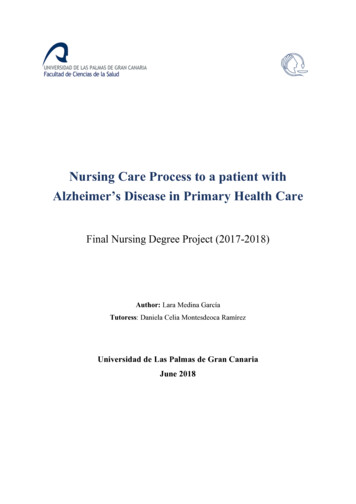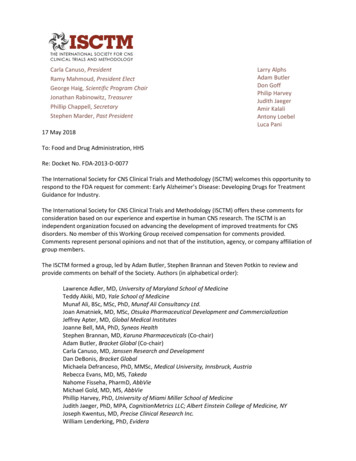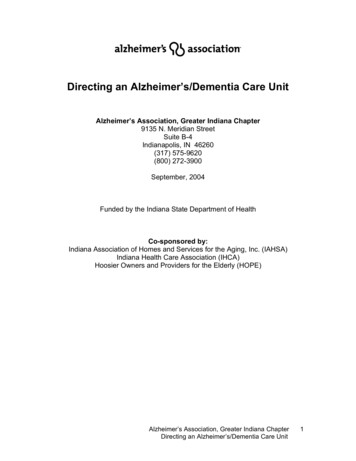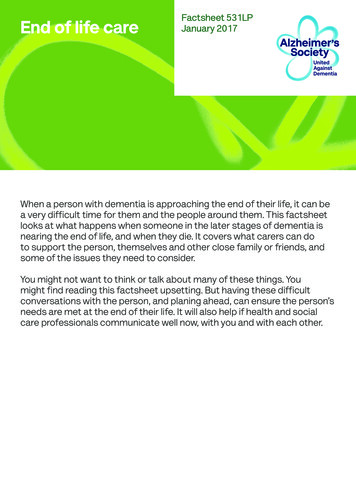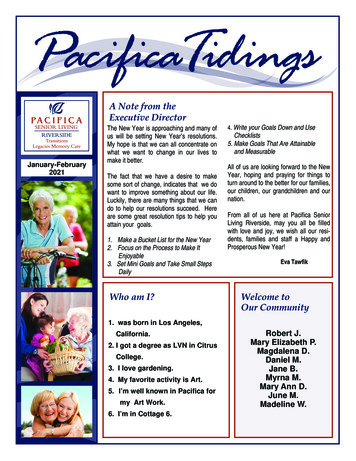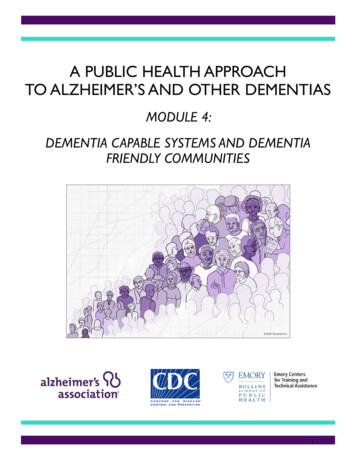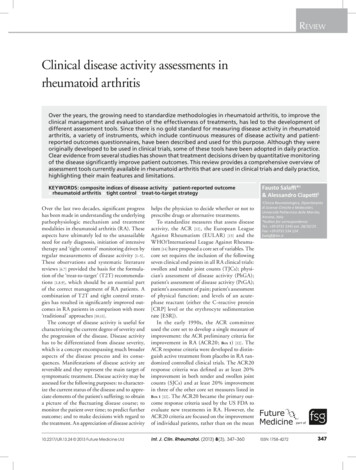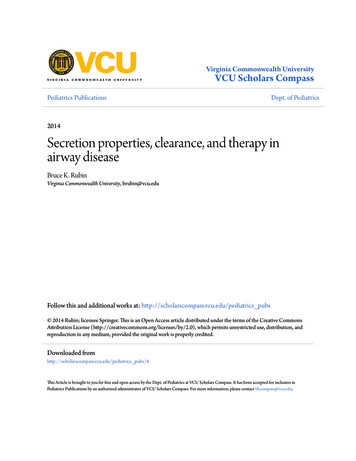
Transcription
Alzheimer’s DiseaseTeaching PlanTo use this lesson for self-study, the learner should read the material, do the activity, and takethe test. For group study, the leader may give each learner a copy of the learning guide and follow thisteaching plan to conduct the lesson. Certificates may be copied for everyone who completes the lesson.Learning objectivesParticipants will be able to:Recognize signs of Alzheimer’s disease (AD).Apply suggestions that may make caring for the AD client easier.Use techniques for handling difficult behaviors in a compassionate way.DiscussionAsk participants to remember a timewhen they faced an unfamiliar situation. Thefirst day of a new job, for example, usuallyrequires talking to strangers, figuring outunfamiliar routines and tasks, and gettingaround in a strange building. Encourage thelearners to tell you how they feel in suchsituations. Some natural feelings , or even fear.Explain to participants that a personwith Alzheimer’s disease feels this way allthe time. The world is more puzzling to themevery day. Everyone seems to be astranger, nothing seems familiar, andabilities they used to have are gone. Whenwe try to see situations from the point ofview of the person with Alzheimer’s, it iseasy to understand why they are sometimesanxious, irritable, or upset.Lesson activitiesDistribute index cards or paper. Ask each learner to write down a problem or questionabout caring for people with Alzheimer’s disease. Have the learners fold the papers or cardsand place them in a box or basket you provide.Hand out copies of the learning guide. Have each learner draw a card from the basket.Instruct the learners to read the learning guide and try to find an answer to the question orproblem. Allow enough time for everyone to find their answer, and then ask learners to readtheir question or problem aloud to the group and explain the answer they found. If there is noanswer for the problem in the learning guide, have learners discuss possible solutions based onthe principles in the lesson.Discuss the important points of the lesson then have learners complete the test. Reviewthe test together. Give certificates to learners with at least 7 correct answers.
Alzheimer’s DiseaseLearning GuideWhat it isCausesComplicationsTreatmentPrevention and researchSignsCaring for the AD clientWhat it isAlzheimer’s disease (AD) is the most common form of dementia. More than 4million Americans have AD. The disease is characterized by memory loss, languagedeterioration, poor judgment, and an indifferent attitude.Dementia is a brain disorder that seriously affects a person’sability to carry out daily activities. It involves the parts of the brain thatcontrol thought, memory, and language. Healthy brain tissue dies ordeteriorates, causing a steady decline in memory and mental abilities.AD is not the only form of dementia. Doctors diagnose Alzheimer’s disease bydoing tests to eliminate all the other possible reasons for the person’s symptoms. If noother cause is found, usually a diagnosis of Alzheimer’s is given.AD causes progressive degeneration of the brain. It may start with slight memoryloss and confusion, but eventually leads to severe, irreversible mental impairment thatdestroys a person’s ability to remember, reason, learn, and imagine. Usually, familymembers notice gradual—not sudden—changes in a person with AD.As AD progresses, symptoms become serious, and familymembers usually seek medical help. Progression from simpleforgetfulness to severe dementia might take five to ten years orlonger.People with mild AD may live alone and function fairly well.People with moderate AD may need some type of assistance. People with advancedAD generally require total care.
CausesThink of the way electricity travels along wires froma power source to the point of use. Messages travelthrough the brain in a similar way, but they are carried bychemicals instead of wires. Information travels through thenerve cells in the brain so we can remember,communicate, think, and perform activities.Researchers have found that people with AD havelower levels of the chemicals that carry these important messages from one brain cell toanother. In addition, people with AD have many damaged or dead nerve cells in areasof the brain that are vital to memory and other mental abilities. Although the person’smind still contains memories and knowledge, it may be impossible to find and use theinformation in the brain because of AD.Abnormal structures called plaques and tangles are another characteristic of AD.Plaques. It is believed that plaque deposits form between brain cells early inthe disease process.Tangles. This refers to the way that brain cells become twisted, causingdamage and nerve cell death.These structures block the movement of messages through the brain, causingmemory loss, confusion, and personality changes.The person with AD has no control over these symptoms and cannot be heldresponsible for behavior problems.ComplicationsMost people with AD die from another illness, not from AD.In advanced AD people lose the ability to do normal activities andcare for their own needs. They may have difficulty eating, going tothe bathroom, or taking care of their personal hygiene. They maywander away, get lost, or become injured. They may developcomplicating health problems such as pneumonia, infections, falls, and fractures.TreatmentThere is no cure. Medications are available that may slow AD, lessening thesymptoms, but they are unable to stop or reverse the disease. These include tacrine(Cognex), donepezil (Aricept), rivastigamine (Exelon), and galantamine (Reminyl).Medicines are sometimes ordered to help with symptoms such as sleeplessness,wandering, anxiety, agitation, and depression.
Prevention and researchThere is no known way to prevent AD. Researchers continue to look for ways toreduce the risk of this disease.It is believed that lifelong mental exerciseand learning may create more connectionsbetween nerve cells and delay the onset ofdementia. People should be encouraged to learnnew things and stay mentally active as long aspossible.Caring for the AD clientAD progresses at a different rate with each person. It is important to focus on thingsthat the person with AD can still do and enjoy.All persons with AD need unconditional love and constant reassurance,no matter what stage of the disease they are in.You will recognize these signs in many clients with AD:Increasing and persistent forgetfulness.Difficulty finding the right word.Loss of judgment.Difficulty performing familiar activities such as brushing teeth or bathing.Personality changes such as irritability, anxiety, pacing, and restlessness.Depression. Depression may show itself in some of these ways: Wandering.Anxiety—this can be caused by noise, feeling rushed, and by large groups.Weight loss.Sleep disturbance.Pacing and agitation. Agitation often is a symptom ofunderlying illness or pain. Medication can also causeagitation, as can changes in the environment.Cursing or threatening language.Disorientation, delusions, or hallucinations. A person with hallucinations sees, hears,or feels things that are not there. A person with delusions believes strongly insomething that is not true, such as believing that he has been captured by enemies.Difficulties with abstract thinking or complex tasks. Balancing a checkbook,recognizing and understanding numbers, or reading may be impossible.
These suggestions will help you care for a client with AD:Structure. Serenity and stability reduce behavior problems. When a person with ADbecomes upset, the ability to think clearly declines even more.Follow a regular daily routine.o Plan the schedule to match the person’s normal, preferred routine.o Find the best time of day to do things, when the person is most capable.Keep familiar objects and pictures around.Bathing. Some people with AD won’t mind bathing. For others it is a confusing,frightening experience. Plan the bath close to the same timeevery day. Be patient and calm. Allow the client to do as much ofthe bath as possible. Never leave the client alone in the bath orshower. A shower or bath may not be necessary every day—try asponge or partial bath some days.Dressing. Allow extra time so the client won’t feel rushed. Encourage the client to do asmuch of the dressing as possible.Eating. Some clients will need encouragement to eat, while others will eat all the time.A quiet, calm atmosphere may help the client focus on the meal. Finger foods will helpthose who struggle with utensils.Incontinence. Set a routine for taking the client to the bathroom, such as every threehours during the day. Don’t wait for the client to ask. Many people with AD experienceincontinence as the disease progresses. Be understanding when accidents happen.Communication. When talking, stand where the client can see you. Use simplesentences and speak slowly. Focus attention with gentle touching if permitted.Environment. Make the environment familiar and safe. Set the water heater no higherthan 120 . Keep medicines and any potentially dangerous items out of reach.Exercise. This helps clients improve their motor skills,functional abilities, energy, circulation, stamina, mood,sleep, and elimination.Avoid pushing the client to exercise, but provideencouragement. Give simple instructions. Mild stretchingexercises are good. Demonstrate how to tense and releasemuscle groups in sequence, keeping the order the same each time. Exercise or walk atthe same time each day. A daily walk may reduce wandering.Night ritual. Behavior is often worse at night. Create a ritual that is calming. Soothingmusic is helpful for some. Leave a night light on to reduce confusion and restlessness.
Ideas for dealing with difficult behaviorsSundown syndrome. Many clients with AD are more agitated,confused, or restless in the late afternoon or early evening.Research shows the following things help:Leave lights on and shut out the darkness by closing blinds and shades.Provide more activity earlier in the day. This will use up energy, reducing stress.Schedule essential activities and appointments early in the day.Encourage an afternoon nap every day. This reducesfatigue and agitation.Play classical music on a portable radio or tape/CD playerthrough headphones or earpieces. This shuts out disturbingnoises and soothes the client.Warm, relaxing baths, foot soaks, or massages may help.Reduce activity and distractions toward the end of the day.Discourage evening visits and outings.Avoid overstimulation. Turn off the television or radio before speaking to a client.Keep the client well hydrated by offering plenty of water throughout the day.Hiding, hoarding, and rummaging. These common problems can be disturbing tocaregivers and to others the AD client lives with. Try these strategies:Lock doors and closets.Put a sign that says “No” on places you want to keep the person out of, such ascertain rooms, closets, or drawers.Watch for patterns. If a client keeps taking the same thing, give him one of hisown.Don’t leave things lying around in the open; put things away neatly.Make duplicates of important items like keys and eyeglasses.Keep the person’s closet open so she can see herthings in plain view. When the client can see at alltimes that she still has her everyday items, shemay not feel the need to go looking for them.Designate an easily reached drawer as a rummagedrawer. Fill it with interesting, harmless items likeold keys on chains, trinkets, or plastic kitchenimplements. Allow the client to rummage freely inthis drawer.Look through waste cans when something is lost and before emptying them.Clients with AD tend to have favorite hiding places for things. Look for patterns.Most behaviors have a reason.Look for the reason for the behavior before responding.
Repetition. A person with AD can become fixated on a task and repeat it over and overwithout stopping. Pacing, turning lights on and off, or washing hands repeatedly areexamples of this. As long as the activity isn’t dangerous, there is nothing wrong withletting the person continue doing it. When the time comes that the client must be askedto stop, try these tips:Say “stop,” firmly but quietly.Touch the person gently.Lead the person by the arm away from the activity.Point out something distracting.Say “Thank you for folding all those towels. Now let’s go to dinner.”Confusion. Don’t try to enter the person’s world by pretending to see or hear the thingsthey seem to see or hear. Help the person stay grounded in reality by patiently usingsome of these techniques:Ask questions with yes/no answers.Make positive statements that let the person know what you want. For example,say, “Stand still” instead of, “Don’t move.”Give the person a limited number of choices.Lay out clothes in advance. Keep the wardrobe simple, and try these things:o Avoid buttons and zippers if possible.o Use Velcro fastenings and elastic waistbands.o Limit the number of colors in the wardrobe.o Eliminate accessories.Use memory aids, such as posting a list of the daily routine orputting up a large calendar and clock. Other aids include:o Put name tags on important objects.o Use pictures to communicate if the person doesn’tunderstand words.o Make memory books with pictures of importantpeople and places.o Post reminders about chores or safety measures.o Put a sign that says “No” on things the person shouldn’t touch.o Paint the bathroom door a bright color, and put a brightly colored seatcover on the toilet. These will remind the person where to go.Give simple, precise instructions. Reduce distractions during a task. Give only asmuch guidance as necessary.Say the person’s name and make eye contact to get his attention before touchinghim.Reassure the person if needed, but don’t needlessly distract a client who is doinga task.Each step of a process should be handled as a separate task. Instead of saying,“It’s time for y
o Plan the schedule to match the person’s normal, preferred routine. o Find the best time of day to do things, when the person is most capable. Keep familiar objects and pictures around. Bathing. Some people with AD won’t mind bathing. For others it is a confusing, frightening experience. Plan the bath close to the same time

